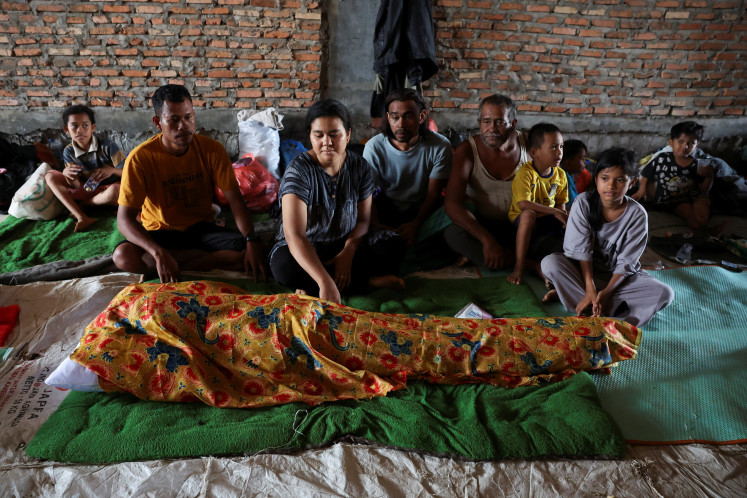Popular Reads
Top Results
Can't find what you're looking for?
View all search resultsPopular Reads
Top Results
Can't find what you're looking for?
View all search resultsChild marriage thrives in urban areas too
Between 2014 and 2016, Rumah Kita Bersama (Rumah KitaB) conducted research on child marriage in Banten, West Java (Cirebon, Cisarua/Bogor, Sukabumi), East Java (Lamongan, Madura), West Nusa Tenggara and South Sulawesi
Change text size
Gift Premium Articles
to Anyone
B
etween 2014 and 2016, Rumah Kita Bersama (Rumah KitaB) conducted research on child marriage in
Banten, West Java (Cirebon, Cisarua/Bogor, Sukabumi), East Java (Lamongan, Madura), West Nusa Tenggara and South Sulawesi.
This study noted the impact of socio-ecological changes in the change of gender relations in families, which has contributed to the practice of child marriage.
It also examined the influence of formal and informal institutions, as well as religious views perpetuated through cultural beliefs and practices, all of which have an impact on the practice of child marriage.
Migration, as a consequence of the changes in socio-ecological space, leaves many girls as the substitute for their parents at home.
At the same time, female sexuality is considered alarming; therefore, it should be expressed only within the institution of marriage.
Meanwhile, those who join the exodus from the countryside to other areas, especially to urban areas and bring along the entire family, threaten the continuity of their children’s education. Such moves can lead to a loss of access to education, for both boys and girls.
As new arrivals with no fixed abode, they bring along their family members to contribute unpaid labor, just so that the family can survive. They live in the outskirts of the cities, in no man’s lands and do various odd jobs in the informal sector.
This interrupted access to education has different impacts on boys and on girls. Boys will become underage workers. While girls also experience this, they are more often encouraged to get married as early as possible. This is not only to reduce the family’s economic burden; many parents feel they can no longer control their daughters’ social relations.
In Asia, Indonesia receives attention as one of the major contributors to this negative practice. In the SDG targets, Indonesia has committed to eliminate all harmful practices, including child marriage.
Yet according to the Central Statistical Agency (BPS), 25 percent of ever-married women aged 20 to 24 were married before the age of 18.
And because of its large population, Indonesia is among the top 10 countries in the world in absolute terms in the number of child brides.
In early August 2016, BPS, supported by the United Nations Children’s Fund (UNICEF), launched a report on “Analysis of Data on Child Marriage in Indonesia” based on data from the National Socioeconomic Survey (Susenas)and the 2010 Population Census (SP 2010).
The report stated that the prevalence of child marriage in Indonesia has declined more than twofold over the past three decades, but is still among the highest in the East Asia and Pacific region.
Meanwhile, the result of the Susenas conducted by BPS in 2012 showed that more than one sixth of girls in Indonesia marry before they reach adulthood.
The report concluded that the prevalence of child marriage in Indonesia is not merely remaining high but actually rising again.
To date, most studies on child marriage have focused on rural areas. This is understandable, as the occurrence and support factors such as poverty, limited access to schooling, and strong traditional values, as well as changes in access to economic resources, especially land, can be identified as factors promoting the practice of child marriage in rural areas.
Yet statistically, there is also a significant level of child marriage in urban areas such as Jakarta, Surabaya and Makassar (BPS, 2013). This generally happens among the urban poor and migrants to the cities.
As new arrivals living in isolated environments such as illegal slums, they are hidden from the affluence of the cities. They rarely have any contact with formal institutions or interact with the moderate religious activities conducted by moderate Islamic organizations such as NU and Muhammadiyah.
Instead, they fall prey for fundamentalist groups, which are more active in going into localities considered socially vulnerable (Testimony of the Faithful Servants, 2013). The conservative views that these groups bring in pose a great risk to the safety of girls, such as the appeal to marry off girls in monogamous or even polygamous unions, to give the parents a sense of security from sinful acts.
Apart from parents, an even greater influence on the practice of child marriage comes from informal institutions such as relatives, neighbors, and “institutions” that are not obvious but persist in the minds of the community or
certain groups: for example, fear of embarrassment from being ridiculed by neighbors, fear of sin, the obligation for girls to relieve the burden on their parents, fear of becoming an “old maid”, and so on.
In this perspective, formal and non-formal institutions are important elements that also condition or at least condone the occurrence of child marriage through these unseen pressures.
Rumah KitaB’s study also mapped various ways that are used by formal institutions in perpetuating child marriage, such as the mechanism of granting dispensations and isbat nikah (retroactive confirmation) for underage marriages that have occurred and require legality from the state, and the use of the “N5” form — a statement letter from the parents granting permission for the Religious Affairs Office (KUA) to conduct a marriage for their child.
Village religious figures also play a role in accommodating illegal marriages, and village officials falsify girls’ ages on official records under pressure from parents and the community, all leading to practices of low-level corruption to earn a bit of extra money. The picture above shows that child marriage occurs not just in rural areas but also in the cities.
More than that, it also indicates that the strategies to address child marriage need to look at the very different conditions between the rural and urban contexts.
The need for contraception services, information for adolescents on their bodies and sexuality, and changes in the content and methods of religious outreach, are all agendas that require attention.
At the same time, the effort to eliminate the corrupt practices in formal and non-formal institutions that support the practice of child marriage is a more complex aspect that also needs to be in the agenda of advocacy to combat the practice of child marriage in urban areas.
_______________________________
The writer is executive director of Rumah Kita Bersama Foundation, an Islamic learning organization.










